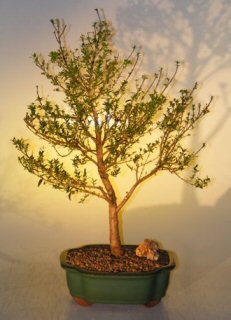 This small evergreen tree is native to the Mediterranean and northern Africa. The ancient Greeks and Romans associated it with love and in Europe today myrtle is frequently included in wedding bouquets. Because of its beauty, vigorous growth, and tolerance to clipping, the ancient Romans used myrtle extensively for topiary and it is a very good bonsai for beginners. The small leaves are oval, rich green in color and fragrant. A profusion of small white fragrant flowers appears in late summer, followed by pea sized black berries that are edible and made into into an aromatic liqueur in Sardinia and Corsica. Myrtle loves heat and require a long hot summer to set flowers. The trunk has reddish brown bark that becomes lightly furrowed with maturity. It is suitable for many styles: formal upright, informal upright, slanting, cascade, semi-cascade, broom, rock-over root, clasped-to-rock, and group planting.
This small evergreen tree is native to the Mediterranean and northern Africa. The ancient Greeks and Romans associated it with love and in Europe today myrtle is frequently included in wedding bouquets. Because of its beauty, vigorous growth, and tolerance to clipping, the ancient Romans used myrtle extensively for topiary and it is a very good bonsai for beginners. The small leaves are oval, rich green in color and fragrant. A profusion of small white fragrant flowers appears in late summer, followed by pea sized black berries that are edible and made into into an aromatic liqueur in Sardinia and Corsica. Myrtle loves heat and require a long hot summer to set flowers. The trunk has reddish brown bark that becomes lightly furrowed with maturity. It is suitable for many styles: formal upright, informal upright, slanting, cascade, semi-cascade, broom, rock-over root, clasped-to-rock, and group planting.
 Position: Myrtle can be kept indoors all year in a very bright, airy location. It can be brought outside in mid spring through summer in a partially sunny location. In the winter it should be brought indoors and placed in a room with bright light and cool temperatures, 39-50o F., to facilitate a rest period.
Position: Myrtle can be kept indoors all year in a very bright, airy location. It can be brought outside in mid spring through summer in a partially sunny location. In the winter it should be brought indoors and placed in a room with bright light and cool temperatures, 39-50o F., to facilitate a rest period.
 Water: The soil should be kept evenly moist and not allowed to become waterlogged. In winter the plant should be watered just enough to keep the soil from becoming completely dry. Tap-water may be used but rainwater is needed if the water is hard as myrtle does not tolerate high concentrations of lime.
Water: The soil should be kept evenly moist and not allowed to become waterlogged. In winter the plant should be watered just enough to keep the soil from becoming completely dry. Tap-water may be used but rainwater is needed if the water is hard as myrtle does not tolerate high concentrations of lime.
 Fertilizer: While the plant is young feed every two weeks from spring to summer with liquid bonsai fertilizer . During the winter when the bonsai is growing in cool temperatures, discontinue feeding. If winter temperatures are above 61o F. a couple of feeding will be necessary during the course of the winter.
Fertilizer: While the plant is young feed every two weeks from spring to summer with liquid bonsai fertilizer . During the winter when the bonsai is growing in cool temperatures, discontinue feeding. If winter temperatures are above 61o F. a couple of feeding will be necessary during the course of the winter.
 Repotting: Repot every three to four years in spring, lightly root pruning at the same time.
Repotting: Repot every three to four years in spring, lightly root pruning at the same time.
 Soil: Use a bonsai soil or a mix of loam, peat moss, and sand at a ratio of 1:1:2.
Soil: Use a bonsai soil or a mix of loam, peat moss, and sand at a ratio of 1:1:2.
 Pruning: Cut back new growth on young plants to two to three leaves when it reaches 4 inches long. Pruning can be done any time but is best performed during the rest period, especially if you want flowers.
Pruning: Cut back new growth on young plants to two to three leaves when it reaches 4 inches long. Pruning can be done any time but is best performed during the rest period, especially if you want flowers.
 Wiring: Wire 2-3 year old, lignified branches in spring. Older branches are brittle and break easily.
Wiring: Wire 2-3 year old, lignified branches in spring. Older branches are brittle and break easily.
 Propagation: Cuttings root easily throughout most of the year; harvest seeds when berries are ripe, remove them from the fruit pulp, and sew immediately.
Propagation: Cuttings root easily throughout most of the year; harvest seeds when berries are ripe, remove them from the fruit pulp, and sew immediately.
